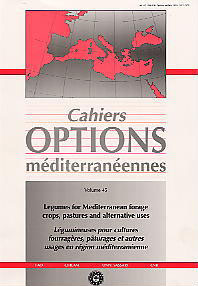| Article précédent | p. 133-136 | Article suivant |
Influences of the phosphoric fertilizers on the fertility of the soil in pasture areas of the dehesa of Extremadura
The methods of improving the pastures (production and preservation) in the Extremadura 'dehesa' are based on: legumes, phosphorus and grazing. Traditionally superphosphate of lime at 18 per cent has been used annually to supply phosphorus to the pastures. In this paper the method (superficial or subsoil) and time of application as well as an ecological alternative to the superphosphate of lime such as phosphoric and peletizada rock are discussed. In the second year the results obtained in soils covered in winter and spring were limited for granite soils and not significant for slate soils. With the exception of Pradillo (Trasierra) where the levels of vegetal cover were close to critical for these areas (risk of erosion), the rest of the data were good or very good and without risk of erosion, specially in winter. The levels of fertility ( Olsen phosphorus and organic matter) were higher in the second year in an important part of the treatments and tests in which phosphorus was applied, especially in granite soil.
- [ Afficher ]
- [ Télécharger ]
- [ Exporter la citation ]
Vous pouvez télécharger la citation au format :
- [ Imprimer ]
-
Mots-clés
ESPAGNE, PATURAGES, PHOSPHATE, PHOSPHATE NATUREL, REGION MEDITERRANEENNECiter cet article
Viguera F.J., Olea L., Coleto J.M., Bartolomé T. Influences of the phosphoric fertilizers on the fertility of the soil in pasture areas of the dehesa of Extremadura. In : Sulas L. (ed.). Legumes for Mediterranean forage crops, pastures and alternative uses . Zaragoza : CIHEAM, 2000. p. 133-136. (Cahiers Options Méditerranéennes; n. 45). 10. Meeting of the Mediterranean Sub-Network of the FAO-CIHEAM Inter-Regional Cooperative Research and Development Network on Pastures and Fodder Crops, 2000/04/04-09, Sassari (Italy). http://om.ciheam.org/om/pdf/c45/00600182.pdf



